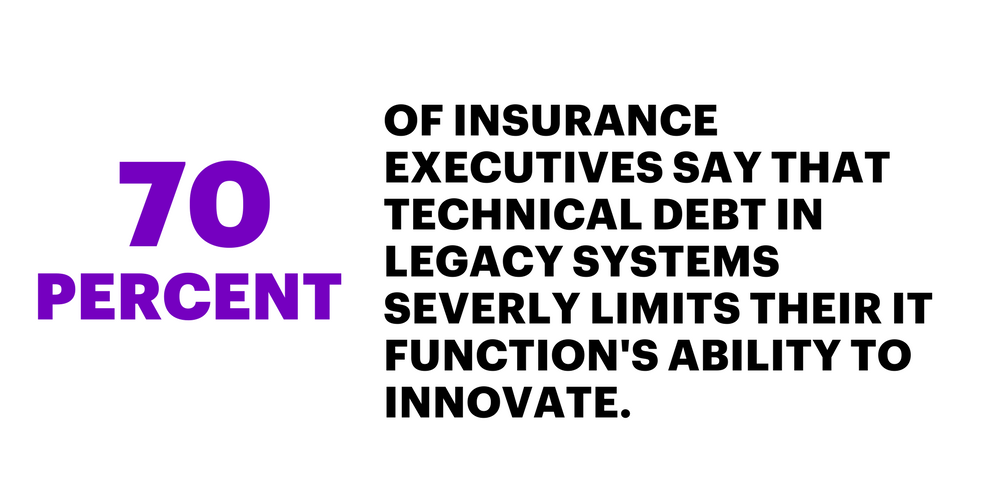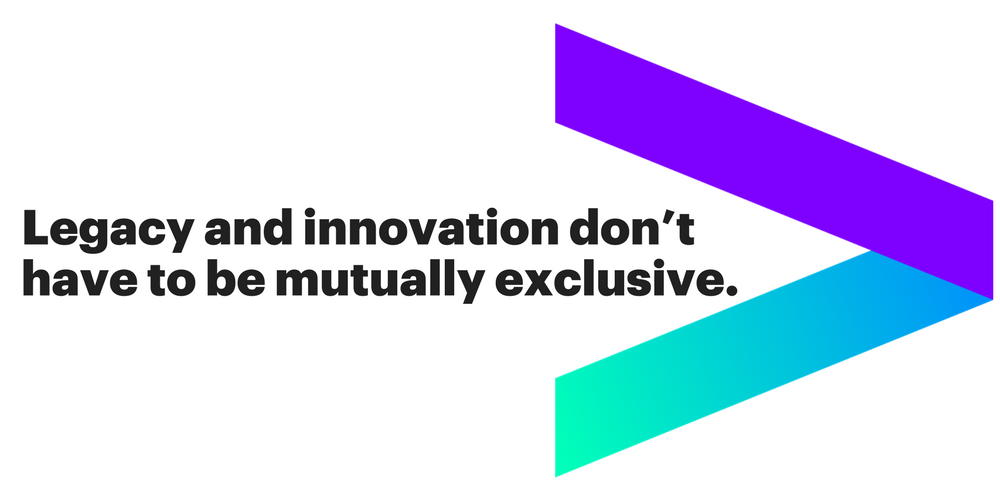This is the fifth part of a five-part series. The previous articles can be found here, here, here and here.
If you’re just tuning in to this series, here’s a brief recap of what we’ve discussed so far: Insurance is ripe for disruption, and insurers must balance two measures to respond. They need to get the Brilliant Basics right, and they need to innovate with Cutting New Ground initiatives. Both are necessary, as Brilliant Basics enable core transformation, which in turn frees up investment capital and enables the agility needed to innovate.
It’s about this point in the conversation when insurance leaders start looking uneasy. That’s when the elephant in the room starts knocking over the furniture. The elephant is legacy: legacy thinking, legacy processes and, most definitely, legacy systems.
Legacy is a legitimate concern. Chronic underinvestment in IT and growth through acquisitions has left many insurers facing high technical debt—the amount of money it would take to get legacy systems to a state fit for today’s business environment.
 Digital decoupling for an intelligent enterprise
Digital decoupling for an intelligent enterprise
Insurers can look to new digital architectures to help address the issues of legacy. For example, cloud services, data lakes, microservices, open APIs and robotic process automation can not only reduce dependency on—and the cost of maintaining—legacy systems but also help them execute business strategy more quickly.
See also: Innovation Is Really Happening
Accenture calls this digital decoupling. Digital decoupling is a way to release an organization from its dependency on legacy systems. In many cases, we can rebuild the capabilities needed for the back office in the cloud, without the convolution of the legacy system. Robots and cognitive processes can help identify where the cloud-based system needs to plug into the legacy system. Digital decoupling can deliver savings to release capital for investments. It also contributes to the stable foundation required to underpin agility and support innovation. Let’s look at a few ways that digital decoupling can help insurers.
Case study 1: Buy a car…while you’re in the car
One global bank was mired in legacy systems but wanted to grow its car financing market. Accenture helped it launch the capability to have customers buy a car
when they’re in the car. Think of it: You’re immersed in the new-car smell, fresh off a test drive. With the push of a button and a digital signature, you can buy the car, along with the financing, insurance and extended warranty. Talk about delivering a knockout customer experience at the moment of truth.
Accenture made it happen in just three quarters. We used cloud-based digital tools to rebuild the bank’s back office, enabling almost exclusively straight-through processing. Next, the cloud-based back office was integrated into essential enterprise systems, but otherwise bypassed the legacy system. The cloud-based office is 50% cheaper to run, creating an immediate cost advantage over the competition. And in this particular market, where the economy declined by 8% over the past two years, the bank’s car sales are up 30%.
Case study 2: Robots enable Sunday mortgages
This particular bank had a mortgage office with typical office hours: Monday through Friday, 9 am to 5 pm. But when do people buy houses—and, therefore, when do they need mortgages? The weekend. But in this region, weekend mortgages weren’t possible.
Accenture worked with this banking client to develop an AI-backed mortgage capability. Robots worked beside people to learn how to make mortgage decisions. When the people go home for the day, the robots keep working. Today, if you want a mortgage on a Sunday, you can get one—and, more important, you can buy your dream home.
Accenture tapped into new technologies to bypass this bank’s legacy systems to deliver the AI-backed mortgage capability in just 20 weeks.

What’s notable about these digital decoupling efforts is that they tend to be self-funded, especially when data lakes are leveraged. For example, using data lakes and other technologies, Accenture was able to create an entirely new bank in about six months—and eventually, as the business shifted to the data lake from the mainframe, the project became self-funding. Using data lakes, in particular, tends to result in a new architecture that is more efficient and cheaper to run than the legacy system.
See also: Linking Innovation With Strategy
With digital decoupling, insurers can innovate without being shackled by their legacy systems. Think of it as two-speed IT. You can move fast with innovation by decoupling the back end. Meanwhile, you have time to move slowly later as you start shutting down parts of the legacy system—a process that releases even more trapped value.
 Digital decoupling for an intelligent enterprise
Insurers can look to new digital architectures to help address the issues of legacy. For example, cloud services, data lakes, microservices, open APIs and robotic process automation can not only reduce dependency on—and the cost of maintaining—legacy systems but also help them execute business strategy more quickly.
See also: Innovation Is Really Happening
Accenture calls this digital decoupling. Digital decoupling is a way to release an organization from its dependency on legacy systems. In many cases, we can rebuild the capabilities needed for the back office in the cloud, without the convolution of the legacy system. Robots and cognitive processes can help identify where the cloud-based system needs to plug into the legacy system. Digital decoupling can deliver savings to release capital for investments. It also contributes to the stable foundation required to underpin agility and support innovation. Let’s look at a few ways that digital decoupling can help insurers.
Case study 1: Buy a car…while you’re in the car
One global bank was mired in legacy systems but wanted to grow its car financing market. Accenture helped it launch the capability to have customers buy a car when they’re in the car. Think of it: You’re immersed in the new-car smell, fresh off a test drive. With the push of a button and a digital signature, you can buy the car, along with the financing, insurance and extended warranty. Talk about delivering a knockout customer experience at the moment of truth.
Accenture made it happen in just three quarters. We used cloud-based digital tools to rebuild the bank’s back office, enabling almost exclusively straight-through processing. Next, the cloud-based back office was integrated into essential enterprise systems, but otherwise bypassed the legacy system. The cloud-based office is 50% cheaper to run, creating an immediate cost advantage over the competition. And in this particular market, where the economy declined by 8% over the past two years, the bank’s car sales are up 30%.
Case study 2: Robots enable Sunday mortgages
This particular bank had a mortgage office with typical office hours: Monday through Friday, 9 am to 5 pm. But when do people buy houses—and, therefore, when do they need mortgages? The weekend. But in this region, weekend mortgages weren’t possible.
Accenture worked with this banking client to develop an AI-backed mortgage capability. Robots worked beside people to learn how to make mortgage decisions. When the people go home for the day, the robots keep working. Today, if you want a mortgage on a Sunday, you can get one—and, more important, you can buy your dream home.
Accenture tapped into new technologies to bypass this bank’s legacy systems to deliver the AI-backed mortgage capability in just 20 weeks.
Digital decoupling for an intelligent enterprise
Insurers can look to new digital architectures to help address the issues of legacy. For example, cloud services, data lakes, microservices, open APIs and robotic process automation can not only reduce dependency on—and the cost of maintaining—legacy systems but also help them execute business strategy more quickly.
See also: Innovation Is Really Happening
Accenture calls this digital decoupling. Digital decoupling is a way to release an organization from its dependency on legacy systems. In many cases, we can rebuild the capabilities needed for the back office in the cloud, without the convolution of the legacy system. Robots and cognitive processes can help identify where the cloud-based system needs to plug into the legacy system. Digital decoupling can deliver savings to release capital for investments. It also contributes to the stable foundation required to underpin agility and support innovation. Let’s look at a few ways that digital decoupling can help insurers.
Case study 1: Buy a car…while you’re in the car
One global bank was mired in legacy systems but wanted to grow its car financing market. Accenture helped it launch the capability to have customers buy a car when they’re in the car. Think of it: You’re immersed in the new-car smell, fresh off a test drive. With the push of a button and a digital signature, you can buy the car, along with the financing, insurance and extended warranty. Talk about delivering a knockout customer experience at the moment of truth.
Accenture made it happen in just three quarters. We used cloud-based digital tools to rebuild the bank’s back office, enabling almost exclusively straight-through processing. Next, the cloud-based back office was integrated into essential enterprise systems, but otherwise bypassed the legacy system. The cloud-based office is 50% cheaper to run, creating an immediate cost advantage over the competition. And in this particular market, where the economy declined by 8% over the past two years, the bank’s car sales are up 30%.
Case study 2: Robots enable Sunday mortgages
This particular bank had a mortgage office with typical office hours: Monday through Friday, 9 am to 5 pm. But when do people buy houses—and, therefore, when do they need mortgages? The weekend. But in this region, weekend mortgages weren’t possible.
Accenture worked with this banking client to develop an AI-backed mortgage capability. Robots worked beside people to learn how to make mortgage decisions. When the people go home for the day, the robots keep working. Today, if you want a mortgage on a Sunday, you can get one—and, more important, you can buy your dream home.
Accenture tapped into new technologies to bypass this bank’s legacy systems to deliver the AI-backed mortgage capability in just 20 weeks.
 What’s notable about these digital decoupling efforts is that they tend to be self-funded, especially when data lakes are leveraged. For example, using data lakes and other technologies, Accenture was able to create an entirely new bank in about six months—and eventually, as the business shifted to the data lake from the mainframe, the project became self-funding. Using data lakes, in particular, tends to result in a new architecture that is more efficient and cheaper to run than the legacy system.
See also: Linking Innovation With Strategy
With digital decoupling, insurers can innovate without being shackled by their legacy systems. Think of it as two-speed IT. You can move fast with innovation by decoupling the back end. Meanwhile, you have time to move slowly later as you start shutting down parts of the legacy system—a process that releases even more trapped value.
What’s notable about these digital decoupling efforts is that they tend to be self-funded, especially when data lakes are leveraged. For example, using data lakes and other technologies, Accenture was able to create an entirely new bank in about six months—and eventually, as the business shifted to the data lake from the mainframe, the project became self-funding. Using data lakes, in particular, tends to result in a new architecture that is more efficient and cheaper to run than the legacy system.
See also: Linking Innovation With Strategy
With digital decoupling, insurers can innovate without being shackled by their legacy systems. Think of it as two-speed IT. You can move fast with innovation by decoupling the back end. Meanwhile, you have time to move slowly later as you start shutting down parts of the legacy system—a process that releases even more trapped value.







